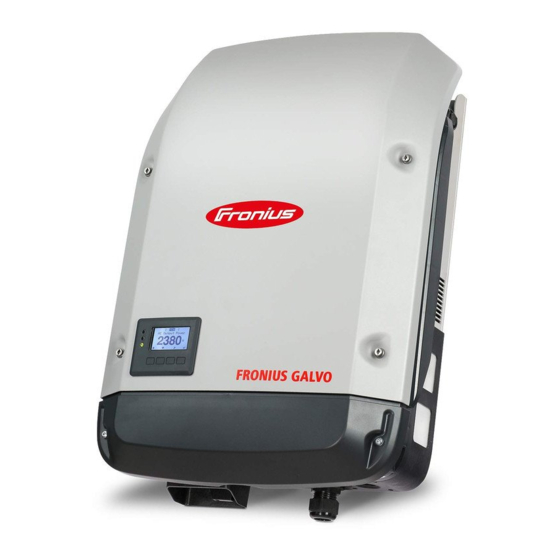
Table of Contents
Advertisement
Quick Links
Advertisement
Table of Contents

Summarization of Contents
Installation Location and Position
Explanation of Safety Notices
Explains the meaning of danger, warning, caution, and note symbols.
General Safety Warnings
Details dangers of incorrect operation, work, and fire prevention.
Proper Use and Intended Purpose
Defines the inverter's intended use and prohibited applications.
Location Symbols and Guidelines
Illustrates symbols for indoor/outdoor installation, altitude limits, and unsuitable environments.
Installation Position Symbols
Shows symbols for vertical, horizontal, and angled mounting orientations.
General Location Considerations
Discusses ambient temperature, humidity, airflow, and mounting surface requirements.
Mounting Bracket Installation
Mounting Bracket Safety
Warns about residual voltage in capacitors and dirt/water on terminals.
Wall Fixings and Screws
Advises on choosing appropriate fixings and screws based on surface type.
Fitting Mounting Bracket to Wall
Illustrates steps for attaching the mounting bracket to a wall.
Mounting Bracket for Other Surfaces
Details mounting the bracket on masts or metal supports.
AC Grid Connection
AC Connection Safety Warnings
Warns about incorrect operation, electric shock from grid/DC voltage.
Grid Monitoring Considerations
Discusses optimizing resistance for grid monitoring.
AC Terminal Connections
Details terminal layout, conductor size, and connection requirements.
AC Cable Types and Preparation
Lists supported AC cable types and preparation steps for aluminium.
Neutral Conductor Requirements
Explains the need for a grounded neutral conductor and proper sizing.
Connecting to the Public Grid (AC)
Illustrates the physical connection process for AC cables.
AC Cable Routing
Provides guidelines for looping and securing AC cables to prevent damage.
AC Side Fuse Rating
Specifies the maximum fuse rating for the AC side and lists inverter models with their ratings.
DC Solar Module Connection
DC Connection Safety Warnings
Warns about incorrect operation, electric shock from solar modules, and grounding.
Solar Module Information
Provides information on open circuit voltage limits and temperature coefficients.
DC Terminal Connections
Details DC terminal layout, cable cross-sections, and connection requirements.
Connecting Aluminium DC Cables
Outlines steps to prepare aluminium DC cables for connection.
Checking DC Polarity and Voltage
Emphasizes checking polarity and voltage before connecting DC strings to avoid damage.
Notes on Dummy Devices
Warns against connecting DC cables to dummy devices.
Inverter DC Connection Procedure
Illustrates the step-by-step process for connecting DC cables to the inverter.
DC Cable Routing
Provides guidelines for routing DC cables to prevent damage during inverter installation.
Solar Module Grounding
General Grounding Information
Explains that some modules require grounding and the inverter provides a fuse holder.
Grounding Fuse Holder Location
Shows the location of the fuse holder for negative pole grounding.
Negative Pole Grounding with Fuse
Details the circuit diagram and recommended fuse for negative pole grounding.
Configuring for Grounded Modules
Explains how to deactivate insulation monitoring and configure error reporting.
Data Communication Setup
Routing Data Communication Cables
Guides on properly routing data cables and using blanking plugs.
Installing the Datamanager
Details the process of installing the Datamanager module into the inverter.
Attaching Inverter to Mounting Bracket
Inverter to Bracket Mounting Safety
Warns about ground conductor connection and ensuring the DC switch is off.
Fastening Screw Tightness
Warns that incorrectly tightened screws can cause arcs and fires.
Initial Startup and Setup
First-Time Inverter Startup
Guides through the initial setup process, including AC reset.
Country Setup Options
Lists available country settings for the inverter configuration.
Software Update Procedures
Software Update Process
Explains how to update inverter software using a USB flash drive.
USB Stick Usage
USB Flash Drive as Datalogger and Storage
Covers datalogger function, data files, and storage capacity.
Inverter Buffer Memory
Explains the buffer memory function for temporary data storage when USB is unplugged.
Recommended USB Flash Drives
Recommends certified industry-grade USB drives and supported file systems.
Updating Inverter Software via USB
Details the process of saving update files to the USB stick.
Safely Removing USB Stick
Provides security notes for removing the USB stick to prevent data loss.
Maintenance and Cleaning
Routine Maintenance Checks
Advises checking screw joints annually for outdoor horizontal installations.
Inverter Cleaning Procedure
Describes cleaning the inverter with a damp cloth, avoiding chemicals.
Cable Protection and Conduit Sealing
Australian Cable Protection Hoses
Ensures cable protection hoses are tightly sealed.
Sealing Conduits
Explains how to seal conduits to prevent condensation damage to the inverter.
Serial Number Sticker
Customer Use Sticker Application
Explains where to find the serial number and how to use the provided stickers.















Need help?
Do you have a question about the Galvo 3.1 and is the answer not in the manual?
Questions and answers